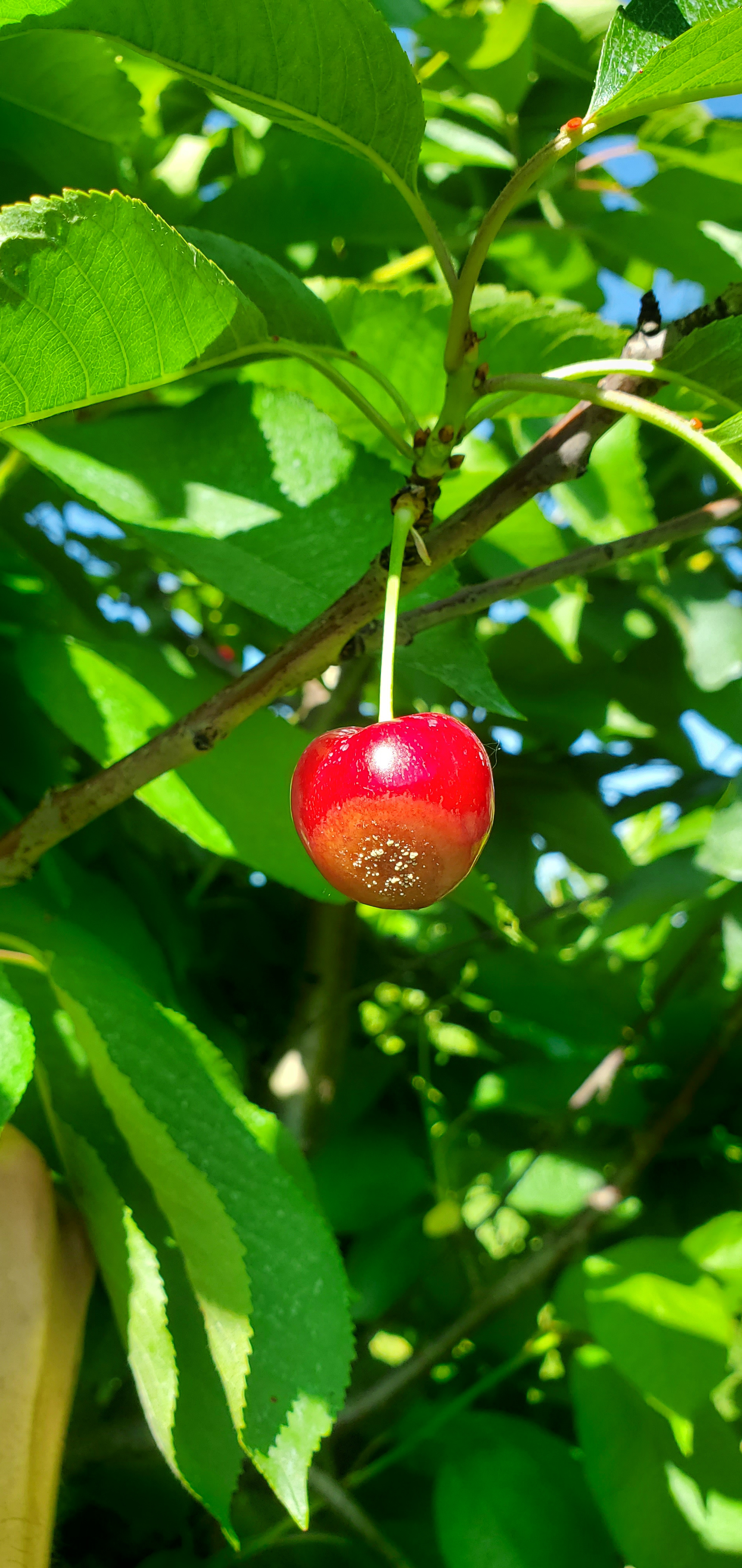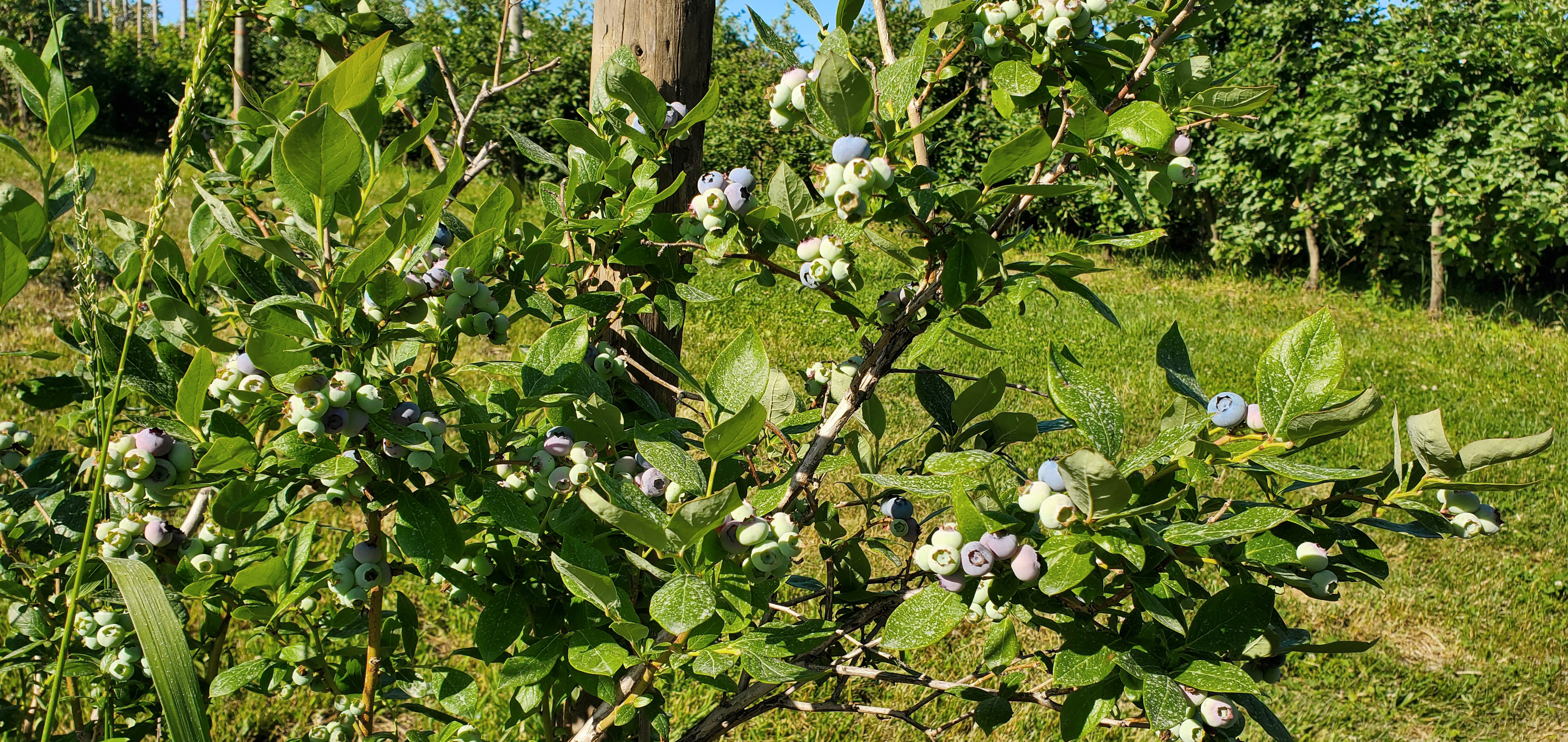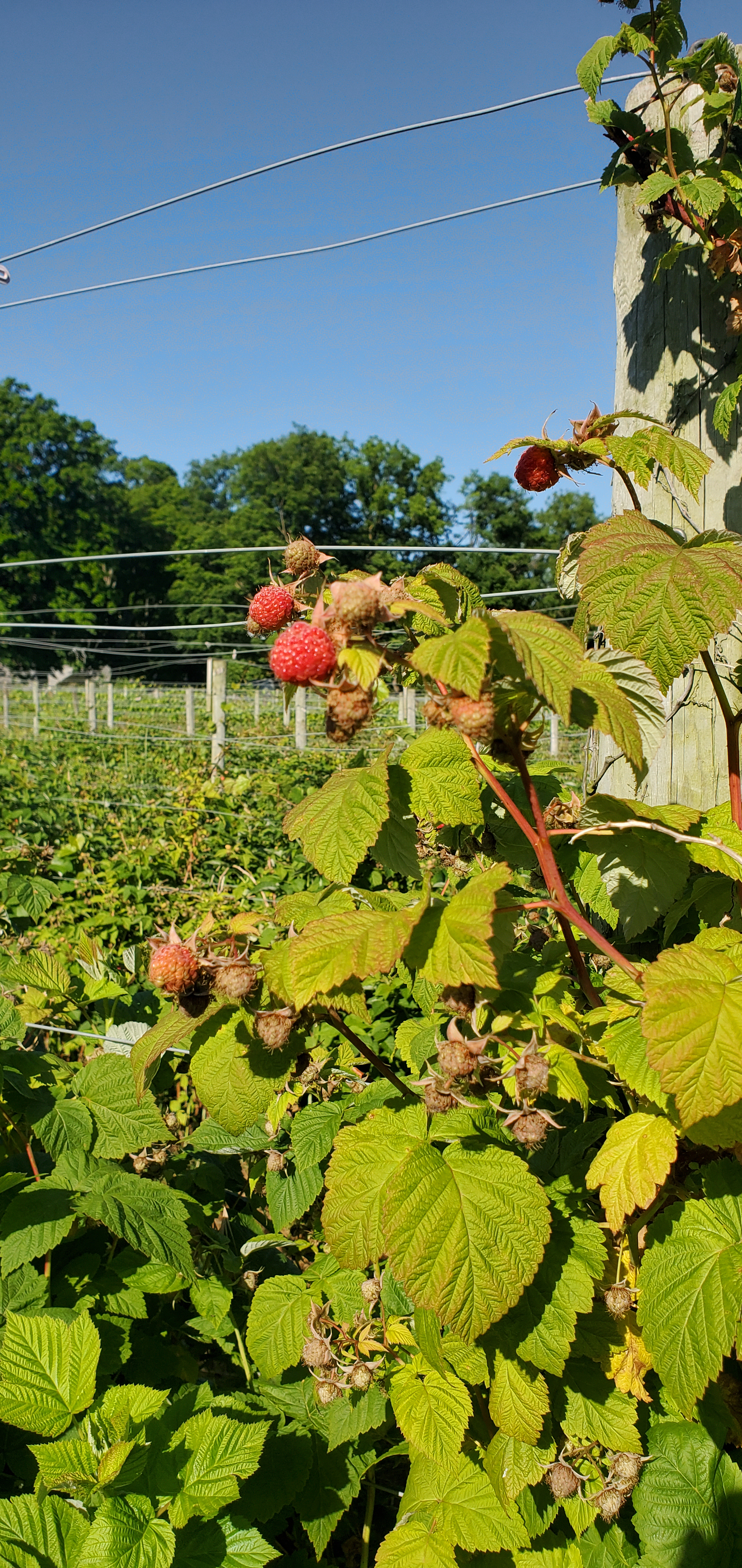Southwest Michigan fruit update – June 21, 2022
Sweet cherry harvest begins this week. Blueberries and raspberries are beginning to turn color.

Weather
Last week started HOT! High temperatures were in the mid to upper 90s, near historical records. Lows on Tuesday and Wednesday were in the 70s. A cold front entering the area late on Thursday brought a brief respite with highs in the 70s for Friday and Saturday before climbing back above average for the by the beginning of this week.
Damage from last Monday’s storm cells was not widespread. Several reports of damage from the Hartford and Three Rivers areas indicate a narrow path with little to no damage a couple miles away. After that line of storms, the region saw little rain activity. Some areas saw a up to a half inch of rain on Thursday.
This week will again begin hot. High temperatures yesterday and today will be in the 90s. A cold front should pass through the area this evening, dropping temperatures into the low 80s for a couple days before rebounding on Friday and Saturday. Small chances of rain are predicted over the weekend when another front is predicted on Saturday evening to bring some cooler temperatures to start next week.
With the HOT week, we picked up a lot of degree days, 226 growing degree days (GDD) base 42, 170 GDD base 50.
|
Southwest Michigan GDD summary from March 1 through June 20, 2022 |
|||
|
Station |
GDD 42 F |
GDD 45 F |
GDD 50 F |
|
Benton Harbor (SWMREC) |
1420 |
1198 |
870 |
|
Lawton (Lawton) |
1417 |
1198 |
873 |
|
Fennville (TNRC) |
1295 |
1083 |
768 |
|
Average for the SW region |
1400 |
1181 |
859 |
|
Average last week |
1174 |
976 |
689 |
Tree fruit
With the sunny weather and high evapotranspiration rates this past week, trees in drought prone areas may start showing stress as the soils continue to dry out. Light colored foliage due to nitrogen deficiency is becoming noticeable as plant reserves are being used up.
Estimated emergence of San Jose scale crawlers is 400 to 450 degree days base 51 after the biofix. The biofix was the start of male flight biofix on May 16, 2022, according to the Trevor Nichols Research Center trapline. Emergence likely began last week throughout southwest Michigan. Management of first generation will reduce damage later in the season.
Codling moth, oriental fruit moth and obliquebanded leafroller are all being caught in traps. Codling moth and obliquebanded leafroller egg laying should be past peak. Second generation oriental fruit moth egg leaying has begun in the last week or so.
Apricot crop is generally light, but better than last year. Some bacterial spot symptoms have been showing up.
Peach and nectarine fruit size is approximately 38 mm diameter for Red Haven in central Berrien County. Pit hardening is still a week or two off. June drop is reducing crop below a full load in some sites. Hand thinning has begun. Estimated harvest date for Redhaven for Berrien County is Aug. 1, about average. Crop potential is for the area is still decent to good. Oxytetracycline should be used instead of copper for bacterial spot to reduce chances of phytotoxicity. Rusty spot management is needed until pit hardening for susceptible peach varieties. Peach scab management is needed now. Both lesser and greater peach tree borer adults are flying. There are trunk spray chemical options beyond chlorpyrifos, but read labels carefully when choosing.
In cherries, tart cherries are turning red. Sweet cherries are softening. Harvest of sweet cherries has begun in select locations. Tart cherry U-pick harvest will begin next week. Both crops look generally good for SW Michigan with some exceptions for some locations that saw an impact from early April cold spells and poor pollination conditions. ProGibb treatment for suppression of bloom on young trees generally starts about 3 weeks after bloom. Cherry leaf spot control should continue. The Enviroweather station in Bainbridge township of Berrien County has recorded 9 cherry leaf spot infection periods since late April, two more than in 2021 at this same time.

In plums, crop potential is generally better for Japanese plums than for European types. Japanese plums are up to 25 mm and European plums are mainly around 22-23mm. Continue black knot management on susceptible cultivars until terminal growth is generally halted. Water-soaked bacterial spot symptoms are showing up on fruit. Internal first generation codling moth damage is showing up in a few sites.
Apple varieties range from 34 to 40 mm in diameter. Seeds and surrounding core flesh are turning brown in fruit that will drop. The primary apple scab spore release period appears to be nearly over. More reports of fire blight symptoms are showing up, but the general level is relatively low. Symptoms trace back to blossom infections. Tarnished plant bug and green fruitworm damage has been seen in the area. Tarnished plant bug becomes active when we see temperatures above 70. Treatments after bloom are typically common for this pest. Codling moth and obliquebanded leafroller egg hatch continues. Damage from the first generation of codling moth is showing up, including wet frass from larval feeding. Egg hatch of the second generation of Oriental fruit moth is beginning.
Pears are at 25 to 30 mm in diameter. Pear psylla adults are present in some blocks. Powdery mildew symptoms are present on terminal foliage of pears. This is the same strain commonly found on apples, but rarely on pears.
Small fruit
Grapes: Juice grapes and variety hybrids are at or near buckshot. Vinifera are nearing the end of bloom. Disease management of phomopsis, black rot, downy and powdery mildews are the primary focus currently. Grape berry moth damage continues to be found. In wine grapes, materials to control botrytis should be included in the sprays. Downy mildew and phomopsis damage is being seen.
Blueberry are beginning to soften and reach final size. Fruit set looks good in many locations. Disease focus should be on early fruit rot management. Cranberry fruitworm and cherry fruitworm are being caught in pheromone traps. According to Enviroweather, egg laying should be finishing for both species. Weed control sprays are continuing.

Strawberry harvest continues. Maintain fungicide coverage to protect the leaves and help prevent fruit rots as fruit continues to ripen, especially with the heat. The heat, humidity and rain have shortened the season for some growers.
Bramble green fruit are visible. Some red fruit are showing up at some sites. Cranberries are blooming.

Currants and gooseberries are coloring up. Champagne and red currant harvest is beginning.
Hops growth continues with some varieties 2-4 feet from the top. Some blocks that were trained early are beginning to set flowers ahead of schedule.
Chestnuts are blooming.
Paw paw fruit are about an inch long.
Upcoming meetings
Our regular Southwest Michigan Monday Fruit IPM Updates has moved to a hybrid format. The meetings are being held in person with virtual attending also available online. Our meetings are on Mondays beginning at 5:30 p.m. June 27 will be our last meeting for the year. You do need to register to receive the Zoom link and password for these meetings. A link is emailed each Monday morning for that evening’s update. The webinars are free of charge and two pesticide applicator credits and certified crop advisor credits are available for each meeting.
The Southwest Michigan Viticulture Field Day will return to the Southwest Michigan Research and Extension Center for 2022. As tradition holds, the event will be the last Wednesday of July (July 27, 2022) and will include presentations of ongoing research in southwest Michigan. The event will once again conclude with a steak dinner and local wine tasting. Registration for the Viticulture Field Day is online through the Michigan Grape Society’s website.
Related articles
- 2022 Fruit insecticide registration update
- Southwest Michigan fruit update – June 14, 2022
- Michigan grape scouting report – June 15, 2022
- Southwest Michigan fruit update – 2021 review
- Managing bacterial canker in sweet cherries: What are the options?
This work is supported by the Crop Protection and Pest Management Program [grant no 2021-70006-35450] from the USDA National Institute of Food and Agriculture.



 Print
Print Email
Email
